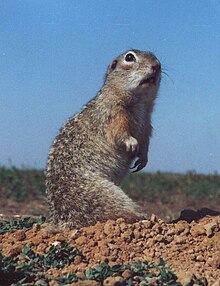Speckled ground squirrel
| Speckled ground squirrel | |
|---|---|
 | |
| Scientific classification | |
| Domain: | Eukaryota |
| Kingdom: | Animalia |
| Phylum: | Chordata |
| Class: | Mammalia |
| Order: | Rodentia |
| Family: | Sciuridae |
| Genus: | Spermophilus |
| Species: | S. suslicus |
| Binomial name | |
| Spermophilus suslicus (Güldenstädt, 1770) | |
| Subspecies | |
| S. s. boristhenicus | |
 | |
| Range of S. suslicus Resident Probably Extant, resident | |
The speckled ground squirrel or spotted souslik (Spermophilus suslicus) is a species of rodent in the family Sciuridae from Eastern Europe.[2] Spermophilus suslicus consists of three subspecies: S. s. boristhenicus, S. s. guttatus, and S. s. suslicus.[3] It is threatened by habitat loss.
Description[edit]
The speckled ground squirrel has dark-brown fur with white spots on its back and a short, thin tail. It grows to a length of 25 cm (10 in) and a weight of 280 g (10 oz). Its dental formula is 1.0.2.31.0.1.3. It is smaller and less social than many other ground squirrels of the genus Spermophilus.[4]
Distribution[edit]
It is found in Belarus, Moldova, Poland, European Russia, and Ukraine. Its natural habitat is temperate grassland and it is also found on cultivated ground. It is threatened by the loss and fragmentation of its habitat. Causes of habitat loss include the expansion of agriculture and forestry, the reduction of pasturing, the development and growth of cities, and industrial development. Also, in some areas it is hunted as an agricultural pest.[1][5]
The speckled ground squirrel's range in Poland and southern Russia has contracted markedly, with only 10% of its area in the mid-twentieth century currently remaining. At the current rate of contraction of its range, the speckled ground squirrel will be extinct from Poland within the next couple decades.[1]
Behavior[edit]

The speckled ground squirrel is a diurnal species which hibernates from October to April. It is active in the morning once the sun warms the area slightly, retreats to its underground den during the heat of the day, then reemerges late in the day for another feeding bout. It feeds mostly on grasses and cereals, although small vertebrates and arthropods are also eaten.[6]
Compared with other Spermophilus species, it lives in a relatively closed habitat with high grasses that block visibility during its active seasons.[4] Individuals live in separate burrows within a larger colony. These colonies can be up to over 160 individuals per ha. It mates between April and May. Gestation ranges from 23 to 26 days. Four to eight cubs are born per litter.[7] Sporadic hybridization occurs where S. suslicus occurs sympatrically with S. pygmaeus and S. citellus.[3]
Predators[edit]
Though there have been no quantitative studies on all the predators of S. suslicus, the weasel Mustela nivalis has been known to enter burrows and cause significant juvenile mortality, though it does not attack adults.[8] However, conspecific predation may be more of a threat to the juvenile speckled ground squirrel than interspecific predators. Though infanticide in the wild has not yet been reported, the speckled ground squirrel has been infanticidal in captivity. The killer can be male, female, or both, and either eats the young or attacks and leaves it to die.[8]
Alarm call[edit]
The speckled ground squirrel uses alarm calls for a variety of purposes. Primarily, the alarm call is used to warn conspecific squirrels of predators and to alert predators that they've been detected [4] Individual-specific alarm calls have been seen in Spermophilus suslicus which also contain age-related features but they lack the ability to distinguish between familiar and unfamiliar individuals nor can they distinguish sex.
References[edit]
- ^ a b c Zagorodnyuk, I.; Glowacinski, Z.; Gondek, A. (2008). "Spermophilus suslicus". IUCN Red List of Threatened Species. 2008: e.T20492A9208074. doi:10.2305/IUCN.UK.2008.RLTS.T20492A9208074.en. Retrieved 15 November 2021.
- ^ Thorington, R.W. Jr; Hoffman, R.S. (2005). "Family Sciuridae". In Wilson, D.E.; Reeder, D.M (eds.). Mammal Species of the World: A Taxonomic and Geographic Reference (3rd ed.). Johns Hopkins University Press. p. 811. ISBN 978-0-8018-8221-0. OCLC 62265494.
- ^ a b Helgen, Kristopher M.; Cole, F. Russel; Helgen, Lauren E.; Wilson, Don E. (2009). "Generic revision in the holarctic ground squirrel genus". Journal of Mammalogy. 90 (2): 270–305. doi:10.1644/07-MAMM-A-309.1.
- ^ a b c Matrosova, Vera A.; Blumstein, Daniel T.; Volodin, Ilya A.; Volodina, Elena V. (March 2011). "The potential to encode sex, age, and individual identity in the alarm calls of three species of Marmotinae". Naturwissenschaften. 98 (3): 181–192. doi:10.1007/s00114-010-0757-9. ISSN 0028-1042. PMC 3040313. PMID 21221515.
- ^ Shilova, S. A.; Neronov, V. V.; Shekarova, O. N.; Savinetskaya, L. E. (2010). "Dynamics of colonies of the speckled ground squirrel ( Spermophilus suslicus Guld., 1770) on the northern boundary of the habitat". Biology Bulletin. 37 (5): 532–536. Bibcode:2010BioBu..37..532S. doi:10.1134/S1062359010050134. S2CID 25563611.
- ^ Edelman, Andrew, ed. (2011). "Spermophilus suslicus". Encyclopedia of Life.
- ^ MacDonald, David; Priscilla Barret (1993). Mammals of Britain & Europe. Vol. 1. London: HarperCollins. p. 230. ISBN 0-00-219779-0.
- ^ a b Matrosova, Vera A.; Volodin, Ilya A.; Volodina, Elena V.; Babitsky, Andrey F. (2007). "Pups crying bass: vocal adaptation for avoidance of age-dependent predation risk in ground squirrels?". Behav Ecol Sociobiol. 62 (2): 181–191. doi:10.1007/s00265-007-0452-9. S2CID 5688475.
External links[edit]
![]() Media related to Spermophilus suslicus at Wikimedia Commons
Media related to Spermophilus suslicus at Wikimedia Commons


 French
French Deutsch
Deutsch